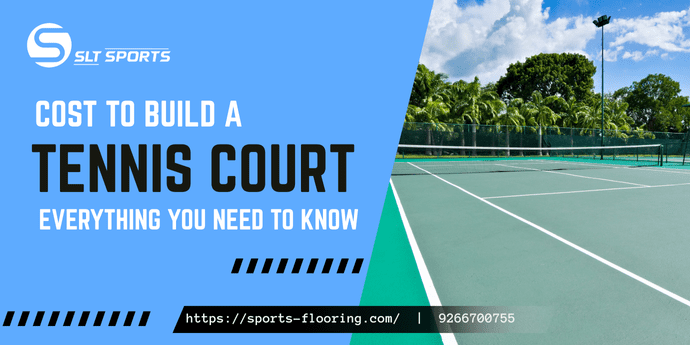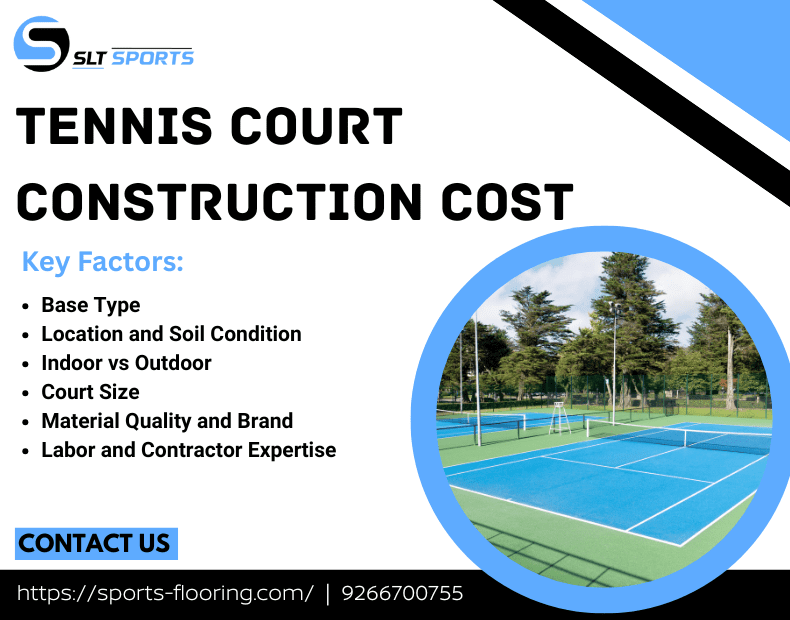
Tennis has moved from being a classical sport for the best to one of the fastest growing and most played sports in India today. What was once limited to premium clubs and international stadiums has now made its way into schools, sports academies, housing societies, resorts, corporate campuses and even private farmhouses and they are now searhing “how much does it cost to build a tennis court”. The sport’s rise can be assigned to its perfect mix of physical fitness, strategic gameplay and global demand. Children are picking it up as a recreational activity, fitness players are embracing it for its cardio benefits and institutions are promoting it as a structured sport to bring up competitive talent from a young age.
As tennis courts continue to grow in popularity, many property owners, educational institutions and residential communities are seriously considering the idea of having a tennis court on their property. A well built tennis court flooring is not just a recreational space, it adds value to a property, enhances its looks and promotes an active healthy lifestyle among residents or students. It can even become a profit generating facility when rented out for training sessions, tournaments or memberships.
But the first and biggest question that rises during this planning phase is how much does it cost to build a tennis court? This is not just about knowing a random figure, understanding the tennis court construction cost is important to set realistic expectations, assign your budget wisely and make sure your investment gives value for years. Without a clear breakdown of costs many projects end up with budget overruns, design compromises or premature surface failures.
How Much Does a Tennis Court Cost in India
When people ask how much a tennis court costs they expect a simple figure. But the truth is there is no single fixed price because tennis court costs are based on size, base type, flooring system, location and accessories.
Here’s an idea of the average cost of building a tennis court in India:
| Court Type | Base Type | Estimated Cost (INR) |
| Hard Court | Asphalt | Low – High |
| Hard Court | Concrete | Low – High |
| Clay Court | Compacted Clay | Low – High |
| Grass Court | Natural Turf | Low – High |
These are suggestive and may be based on location, site conditions, material quality and contractor expertise. Still they give you a good idea of the tennis court cost to build.
Breaking Down the Cost to Build a Tennis Court
To understand how much does a tennis court cost to build, let’s break it down into its main construction stages. Each of these steps important to the total cost:
1. Site Preparation
The first step in building a tennis court is to prepare the site which is the foundation of everything that follows. This involves clearing existing vegetation, removing topsoil and leveling the ground to create a uniform base. In areas with rocky or sloped land, large cutting, filling and soil contraction may be required to stabilize the surface. Drainage channels are often added at this stage to stop waterlogging. Depending on the size of the plot and the condition of the land, this step costs between 3–6 lakh.
2. Base Construction
Once the ground is prepared, a solid base is laid and this is one of the most important stages for long term court durability. The base can be constructed using either asphalt or concrete, both of which provide a flat and stable platform for the playing surface. Asphalt is slightly cheaper and faster to install, so it’s a common choice for outdoor courts, while concrete offers more strength, longevity and resistance to cracking.This step is for an important part of your overall tennis hard court construction cost.
3. Synthetic Acrylic Surfacing
With the base ready, multiple layers of synthetic acrylic coatings are applied to build the actual playing surface. These coatings create a smooth, non-slip and weather resistant finish that make sure consistent ball bounce and player safety. You can also use cushioned acrylic systems which add shock absorbing layers underneath to reduce player exhaustion and risk of injury. Because of their durability and low maintenance, acrylic surfaces are the most preferred option for backyard tennis courts in India.
4. Fencing and Nets
To contain the game and protect the surrounding areas, fencing around the tennis court is a must. These are usually made of chain-link mesh and installed at a height of 10–12 feet and anchored on steel posts. Besides containing the balls from flying out, fencing also makes sure safety by keeping the viewer and bystanders away from the playing area. The setup also includes center net posts and net strap for proper tension.
5. Lighting
If you want to play tennis after sunset, a professional lighting system is a must. This means 4–6 tall poles with high quality LEDs to light the entire court without glare. Modern systems may also have smart features like motion sensors, automatic timers and underground wiring for a clean look. While optional, lighting can extend the usable hours of your tennis court. The cost of a complete lighting system is depending on the coverage and brand.
6. Line Marking, Accessories and Finishing
The final step is to add all the finishing touches that make your tennis court game ready. This includes line marking with durable acrylic paint to make sure ITF standard dimensions and visibility. Additional accessories like benches for players, umpire chairs, windscreens to reduce wind interference, scoreboards and ball holders can also be installed for a professional look. Though minor in cost compared to other stages, these finishing elements are essential for usability and aesthetics and add around to the total cost.
Key Factors That Impact Tennis Court Construction Cost
1. Base
The base is the most important part of your tennis court construction and has the biggest impact on durability. Asphalt is cheaper and faster to install but can crack with temperature changes. Concrete requires a higher upfront cost but less repairs over time. This one decision can impact your backyard tennis court cost.
2. Location and Soil Condition
Where you build your tennis court is important, remote or hilly areas require more transportation, heavy machinery and skilled labor which can increase overall tennis court cost. If the site has poor soil condition, soil support layers or replacement may be needed before construction begins. These additional preparations add to the base cost but are important to stop future surface damage and drainage issues.
3. Indoor vs Outdoor
Deciding between indoor or outdoor will greatly impact your investment. Indoor tennis courts require steel frames, roofing structures, insulation panels and ventilation systems which can double or even triple the cost compared to outdoor builds. Outdoor tennis courts are more budget friendly and simpler to construct making them ideal for schools, academies, clubs and residential properties. This decision should align with your usage and climate.
4. Court Size
The size of your tennis court determines the amount of material and labor required. A standard tennis court offers full play for competitive use. Smaller practice courts, often can be built in limited spaces or backyards at a much lower cost. Reducing the size not only saves on construction but also on future maintenance and resurfacing costs.
5. Material Quality and Brand
The quality of tennis court materials and builder you choose affects both performance and long term cost. Premium acrylic systems offer superior UV resistance, vibrant colors and longer lifespan so your court stays safe and looks great for years. Low grade coatings may fade, crack or peel within 2-3 years forcing early resurfacing and higher maintenance. Investing in quality materials reduces overall cost and increases court value.
6. Labor and Contractor
Skilled and experienced contractors may charge higher fees but deliver exact base leveling, proper slope design and professional finishing for lasting performance. Hiring untrained labor to save money can lead to uneven foundations, cracks, poor drainage and early surface failure. Choosing the right experts ensures your investment stays durable and safe for decades.

Tips to Reduce Tennis Court Cost to Build Without Compromising Quality
Acrylic or Clay or Grass
Synthetic acrylic tennis court surfaces will save money both upfront and in the long run. They are durable, weather proof and low maintenance compared to clay or grass. Clay courts require frequent rolling, watering and surface replacement, grass requires daily trimming and wash. Acrylic performs well year round even in heavy rainfall areas.
Build in the Off-Season
Construction rates drop during off-peak months when there’s less demand for contractors. Building after the monsoon or before peak summer helps you get better labor at lower cost. This can save on your total tennis court construction cost without compromising on quality.
Get Multiple Quotes
Never settle for the first quote you get from a contractor. Ask for detailed reviews from at least two or three experienced sports flooring specialists to compare pricing and materials. This gives you bargaining power and helps you identify hidden charges or missing involvement.
Plan Multipurpose Use
Design your court to serve more than just tennis to increase its ROI. Adding line markings for basketball or pickleball allows different sports to be played on the same surface. This maximizes space used especially in schools, clubs and housing societies with limited land. A multipurpose design also helps justify the upfront cost more easily.
Invest in Good Drainage
Ignoring drainage can lead to costly repairs and resurfacing down the line. A well designed slope and proper water runoff system protects your court base from waterlogging damage. This small expense can add years to your tennis court’s life and reduce future tennis court resurfacing costs. Good drainage makes sure your tennis court is safe, playable and low maintenance all year round.
Is Building a Tennis Court Cost Worth the Investment?
The cost to build a tennis court may seem high at first glance, it’s important to view it as an expense but as a long term investment in your property, lifestyle and community. The average cost of building a tennis court pays for itself over time through financial returns, increased property value and social benefits that go far beyond the initial budget.
Here’s why investing in a tennis court is truly worth it:
Property Value
A tennis court flooring adds appeal and market value to any property. For private villas, farmhouses and luxury housing societies, a well constructed tennis court is a premium facility that attracts buyers and tenants who are willing to pay more for active lifestyle facilities.
Health and Fitness
A tennis court provides a sustainable long term wellness benefit to the users. It promotes daily physical activity, social interaction and active outdoor lifestyle which is especially valuable in urban spaces where open play areas are limited.
Gives Profits
For commercial facilities like sports academies, resorts and educational institutions, a tennis court is more than a sport; it’s a revenue generating asset. Tennis courts can be rented out hourly, used for tournaments or offered as part of membership packages.
Professional Level Training Facilities
A dedicated tennis court allows players to train consistently in a controlled environment which is important for skill development. Schools, colleges and sports academies that invest in professional grade tennis courts provide their athletes with the infrastructure to compete at district, state and national levels.
Durability
With proper planning, base construction and choice of durable synthetic acrylic surfaces a tennis court can last 15-20 years with minimal maintenance and repairs. The tennis hard court construction cost is spread over decades and hence the annual ownership cost is significantly reduced.
Bottom Line
Overall the cost to build a tennis court is more than a one time expense, it’s a strategic investment that enhances lifestyle, increases property value and can even create new revenue opportunities. Whether it’s for personal use, community development or commercial purposes a well built tennis court continues to deliver returns long after the construction is over.
Why Choose SLT Sports For Tennis Court Construction?
Choosing the right partner for tennis court construction can make all the difference in the long term success, safety and quality of your facility. SLT Sports has established itself as one of India’s most trusted names in synthetic acrylic sports flooring and turnkey tennis court construction. With over a decade of hands-on experience the company brings deep technical expertise and a proven track record of building courts that meet international performance standards. The team knows how to navigate complex site conditions, select the right base system and deliver flawless finishes that can withstand India’s varied weather conditions.
One of the key reasons to choose SLT Sports is their unwavering commitment to certified quality. They use ITF and ISO compliant synthetic acrylic materials that are engineered to provide consistent ball bounce, optimal grip and exceptional durability. By using only premium grade products SLT Sports ensures your court remains vibrant, crack free and safe for players even after years of heavy use. This quality first approach minimizes the risk of premature damage and reduces long term maintenance costs and protects your investment. No need to deal with multiple vendors, everything is under one roof site preparation and base construction to surface installation, line marking and accessories. This integrated approach ensures seamless coordination, faster timelines and accountability. Every stage of the project is handled by trained professionals who know how each layer of the court affects the overall performance and longevity.
SLT Sports also offers customization of tennis courts flooring to suit client requirements and aesthetics. Beyond looks, they focus on safety driven construction proper drainage systems, slope designs and slip resistant textures to protect the players and extend the life of the surface.
Conclusion:
The tennis court construction cost may look like a big number at first glance, ranging from ₹25 lakh to ₹60 lakh or more depending on specifications. But this is not just an expense, it’s an investment in quality, safety and long term functionality. Understanding the cost structure helps you plan better, avoid overspending and allocate funds to what matters most – strong base work, professional acrylic surfacing and proper drainage systems.
Whether you are building a public community court for local tournaments or want to build a tennis court in your backyard for family recreation and personal training, investing in high grade materials and expert construction ensures your court remains resilient, visually appealing and safe for decades. Cutting corners on installation might save you money in the short term but often leads to cracks, water damage and expensive resurfacing in just a few years.
So when it comes to answering how much does it cost to build a tennis court, the honest answer is, it depends on your vision but every rupee spent wisely on the right foundation, certified materials and experienced builders will reward you with years of smooth play, less repairs and enhanced property value. A well built tennis court doesn’t just serve the game; it serves your legacy.
Frequently Asked Questions
The cost to build a tennis court in India depends on the base, surface system, fencing, lighting and accessories. Backyard tennis courts or compact practice courts are cheaper while indoor or premium courts with advanced lighting and drainage are more expensive.
The average cost of building a tennis court for a standard hard court with fencing and basic lighting is between ₹30 lakh to ₹40 lakh.
The cost to build a tennis court in your backyard depends on the space and specifications. A compact half-court can cost as low as ₹15–₹20 lakh while a full size backyard court can cost ₹25–₹35 lakh.
Acrylic hard courts are the most cost effective in India. They have moderate installation cost, minimal maintenance and can last 8–10 years before resurfacing.
Site preparation, base type, surface system, fencing height, lighting requirements and location are the key factors. Labour charges, soil condition and custom accessories like benches or windscreens can also impact the total cost.
It takes 6–10 weeks to complete a tennis court project. This includes earthwork, base curing, acrylic layer application and final line marking.
Most acrylic hard courts need resurfacing every 5–7 years depending on usage and maintenance. Regular cleaning, crack repairs and repainting lines can extend the life of the surface and reduce long term costs.

